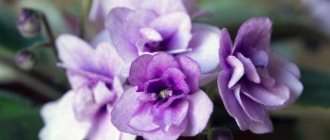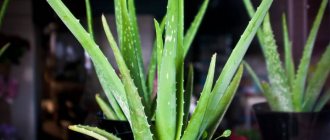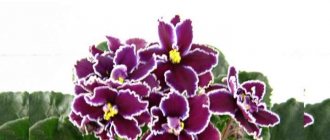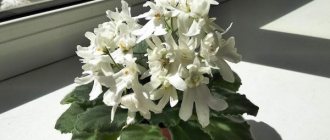Violets are considered one of the most common indoor flowers. The colors come in different colors, but two-color options are especially popular among gardeners. One of them is the Sunny Boy violet, which was bred by the famous Russian breeder Elena Vasilievna Korshunova.
Its flowers are known all over the world and are in great demand. Their diversity is simply amazing. A big plus is their rapid flowering, which can last most of the year.
Description of violet Sunny boy with photos
Violet Sunny Boy - these are flowers with large lemon-white petals, bordered by a blue fringe, with a yellow center and a blue eye. The outlet itself is small. The predominant color is lemon. The shape of the flower resembles a pompom and the size is 6 cm.
The flowers are located so close to each other that together they form a fluffy ball consisting of buds and peduncles, on which there are 5-6 flowers. If the flower is placed in a place with high temperature, blue marks may appear.
The leaves of the plant are green and wavy. It often happens that violet blooms without any yellow color at all, but with age it begins to appear more and more. Often it is the description and photo of a flower that pushes flower growers to grow it.
The main thing is to make sure that there is not a lot of blue, otherwise the violet will go to waste. The typical violet coloring begins to appear after 2-3 blooms. As practice shows, if a plant initially blooms with a pure color, it is not in danger of being darkened by blue.
The Sunny Boy variety is characterized by a rather long blooming of flowers, and this happens alternately. A distinctive feature of this variety of violets is that it begins to bloom quite early - at 10 months
How to care for flowers
Like all other varieties of violets, Sunny Boy is not too whimsical, but certain rules must be followed in its cultivation. This is especially important for those who want to get a beautiful and original violet.
It should be borne in mind that this flower loves a lot of light, but this does not mean that the plant should be placed in direct sunlight. Sufficient humidity is very important for violets. However, the plant will not tolerate stagnation of water in the soil, which will certainly affect its color and can cause the development of diseases.
Sunny Boy does not tolerate spraying, so such a procedure should be excluded. Water the plant exclusively with warm and settled water. For the violet root system, watering through a tray is considered especially useful.
Important. The sunny boy needs to be protected from drafts. The violet also tolerates overheating and dry air very hard, so you should not place the pot next to a heater, radiator or fan.
Periodically, you can add fertilizer to the soil and replant the bush, if necessary. With proper care for the Sunny Boy, within a year he will begin to delight his caring owner with the most beautiful flowers.
Violet Sunny Boy is sensitive to watering regime.
It should be borne in mind that the flowering of the rosette can last up to 2 months, after which the plant takes a short break. All faded flowers should be removed in time to give the violet strength to develop new ones.
In order for Sunny Boy to please with beautiful pedigree flowers and not produce rosettes of the wrong shades, you need to follow the main rule in care. It concerns watering. If the plant is over-watered, it will not only bloom poorly, but may also become diseased.
Violets are susceptible to some dangerous ailments and are afraid of parasites, so preventive measures regarding such flowers will not be superfluous.
Diseases and pests of streptocarpus
Do not violate the rules of care, and pest diseases will not favor streptocarpus. The room is hot and dry - you weren’t expecting thrips, but they came. The plant quickly dries out from such guests. Thrips are destroyed with insecticides and after treatment, problems with air humidity are solved.
If in a dry microclimate the flower is not attacked by thrips, do not worry, it will be occupied by scale insects. Inconspicuous brown plaques can dry out a flower in a short time. Actellik saves you from such a misfortune. When attacked by aphids, the plant is treated with an insecticide and transplanted into healthy soil, not forgetting to completely shake off the previous soil during replanting.
How to get rid of midges in indoor flowers using simple methods. In a special publication on our portal, we will talk in detail about how to get rid of pests in indoor plants. You will learn the reasons for their appearance, the types of midges and their signs and measures to prevent the appearance of midges.
Feeding and replanting violets Sunny boy
To obtain high-quality and lush color of the Sunny Boy, it is recommended to apply fertilizers. This procedure should not be performed too often. Those gardeners who abuse fertilizing can simply destroy a beautiful flower.
It is important to consider that the soil for violets must be correct. It is best to take special substrates that are sold in flower shops. They contain components in optimal proportions. But if you wish, you can make the soil mixture yourself.
For this, peat, sphagnum moss, leaf soil, sand and charcoal are taken. It should be borne in mind that all these components must be properly processed so as not to introduce pests or diseases. The substrate for the Sunny Boy should contain at least 30% moss and coal. The least amount of sand is added.
For better plant growth, experts recommend adding perlite to the soil. It will better retain moisture in lightweight soil. Regardless of the composition of the soil for violets, humate must be added to it once a year.
In order for the Sunny Boy violet to bloom profusely and luxuriantly, it is periodically fed with fertilizers.
In autumn and spring, mineral fertilizers are also used. For the sunny boy, as for other varieties of Saintpaulia, liquid mineral fertilizers are suitable.
There are a lot of nuances to follow when growing violets. It is advisable to pay special attention to the earthen coma. It must be sufficient for the roots to develop normally. However, in a very large pot the flower will not feel well, so such planting is unacceptable.
In any case, someday it will come to a transplant.
In this case, the following features must be taken into account:
- You should prepare the right pot and be sure to stock up on a sufficient amount of fresh substrate. It is believed that for an adult violet a pot 10-12 cm high is sufficient. And a third of this volume should consist of drainage filler. This is important for proper violet flowering. Until the root system fills the entire space with soil, you should not expect flowers.
- When planting, be sure to pay attention to the drainage hole. It should be large enough so that water does not linger in the soil. Otherwise, the violet will hurt.
- During transplantation, you should inspect the roots of the violet.
When replanting, you need to pay attention to what kind of roots the plant will have. In a healthy Sunny boy they are light and completely fill the space of the pot. If you remove the plant, the root system will retain its shape. Diseased roots will be immediately visible by color and appearance. When transplanting, they must be removed.
- For the Sunny Boy violet, the correct temperature is very important. Particular attention should be paid to the temperature regime during the first weeks after transplantation. For summer, the best option would be 25 degrees, and for winter, 20 is enough. Air humidity for good flowering should be 50%.
Care in the home microclimate
Specimens of the varietal variety of violets in indoor gatherings demonstrate a very problem-free nature:
- The most advantageous are those windows that are located on the southeast side - here the plants are most illuminated.
The windows on the south side of the house are better illuminated in winter, but in summer severe overheating is noticeable there, which threatens the plants with burns. Therefore, it is recommended to slightly shade the windows during midday heat. Window sills in the eastern and western directions are considered semi-shaded; here the sun's rays are available to violets only in the first half of the day. Northern windows are the worst suited for placing violets, and then only if they are equipped with additional lighting; - watering the variety should not be carried out too often while simultaneously monitoring the drying of the top layer of the substrate in the flowerpot;
- additional nutrition with mineral fertilizers at a particular moment in time or not, showing their internal state with a decorative appearance.
In the same way, you can find out the plant’s need for certain types of fertilizers. But this procedure of agrotechnical care cannot be abused; - An important role in the life processes of specimens of the variety is played by the optimal lighting regime with a well-chosen structure. For proper growth and healthy flowering, it is necessary to combine long-term illumination of the plant with a natural spectrum with exposure to LED lighting;
- the possible temperature gradient is +20 + 24°C. It is important to prevent its extraordinary jumps and cold drafts;
- timely provision of violets in the home collection with fresh substrate is a necessary condition for maintaining the health of the specimen - this will ensure aeration and water permeability of the soil. In addition, a good drainage system is needed;
- For replanting, it is more correct to use “transshipment”, although it is suitable when working only with healthy violets.
How does a flower reproduce?
Like many other violets, Sunny Boy reproduces in several ways:
- leaves (this is the most convenient way);
- the plant takes root well with cuttings and flower stalks;
- from seeds (the most difficult method).
The most popular propagation of violets is by rooting leaves. To do this, it is enough to take one leaf from the parent bush, cut at an angle. It is immersed in water for a while until small roots appear.
As a rule, this happens within a couple of weeks. When the root reaches a size of 5 mm, you can plant the violet in a pot. It is advisable to cover the plant with film until the first young leaves appear. With proper care, you can expect the first flowers within a year.
Violet blossom Sunny boy
If you pay attention to the description of the variety, the main feature of the Sunny Boy is its unusual color. The flower is distinguished by a lemon center and bluish edging around the edges. At the same time, in order to preserve the plant’s original color, it is necessary to properly care for the violet.
Violet Sunny Boy may change color if the room is too hot.
Sunny boy does not tolerate high humidity and abnormal temperatures very well. This applies to all multi-colored violets, which may change color over time. Most often, darkening of the petals occurs.
As for Sunny Boy, his main problem is blueness. It forms not only due to improper watering, but also simply over time. Therefore, old flowers must be renewed.
This variety can produce different shades of rosette, depending on where the pot is located. There may be one color on the rack, and another on the windowsill. Moreover, the quality of the flower may vary from year to year.
Interesting. The aroma of Sunny Boy is quite typical for terry violets. And the main distinguishing feature of this variety is its rosettes. The flowers appear gradually on them, so the flowering is long, but not too violent. As a rule, 6 lush flowers are formed on one peduncle.
Sunny Boy is considered the variety that blooms quite early. Sometimes the first flowers bloom as early as 10 months. At first, a lot of sports may appear in the rosette, that is, flowers with the wrong color, most often with an excessive amount of blue. But over time, the breed characteristics begin to actively manifest themselves, so soon the florist can admire all the beauty of the Sunny Boy.
Violet Lyon's Red Rocket (S. Sorano)
The author who registered the delightfully proud violet is breeder Paul Sorano, respected in the global violet growing community.
The variety was bred in the Lyndon Lyon Greenhouse owned by the Sorano family in the town of Dolgeville (New York, USA), which Paul has managed since 1982, after the retirement of his grandfather Lyndon Waldo Lyon, the founder of the beautiful family business.
The variety was introduced to flower growers in 2010 , when it was recognized as one of the main novelties of the season, and since then has been highly valued by admirers of Saintpaulias with red corollas.
Violet is recorded in the genus Saintpaulia , which is part of the Gesnerieceae family.
The rosette of the presented variation of Saintpaulia is included in the system of subspecies of standard sizes , and according to the structure of the corollas, the plant is simultaneously included in the subcategory of varieties of simple and semi-double appearance .
Description of the variety
A proudly solemn violet, after easy and final strengthening in the form of an adult plant, can take the form of a bush, intelligently arranged in a neatly tiled arrangement of leaf plates, having a symmetrically verified configuration of forms and creating grandiosely voluminous outlines of flower caps.
The velvety violet acquires a chic exhibition silhouette of compact outlines remarkably simply and seamlessly .
ATTENTION! An important feature of its growth is its calm and easy-going character: the aristocratic-looking rosette is formed absolutely independently, without showing whims regarding minor fluctuations in agrotechnical conditions.
According to the author’s description included in the world registers of violet growing, it is planned for Saintpaulia to maintain a level gradient of standard scales , which plants in cultivation almost always strictly observe.
Medium-sized leaves are distinguished by the textural quilting of the glossy-shimmering layer, the design of slightly wavy-elongated “hearts” with a well-defined presence of a sharply shaped end and a graphically pressed pattern of venation, which attracts attention due to the excessive tuberosity of the structural pattern, a significant density of vein lines and salad tone of the central axis.
The edges of the somewhat wavy leaves are delicately framed with neatly sculpted, rounded-medium teeth. The texture of the plates is dense and juicy.
INTERESTING! There is a slight bending of their edges towards the flowerpot and a slight “boat” effect.
The color of the leaves of the violet bushes is maintained in dark variations of the malachite-green palette. The reverse side has a reddish coating.
The varietal violet is characterized by a fairly abundant process of blooming of spectacularly proud, simple or semi-double flowers, allocated to the “star” segment.
The corollas are of significant size and have wavy petals with excessively fringed frills along the contour , which in general, with their multiple numbers, creates a feeling of lush, sublime fullness of flower bouquets.
The color scheme of Saintpaulia corollas is based on the design of their petals of the main red-burgundy color scheme of deep intensity with darker, but the same color veins, diverging in wide rays from the center, as well as variably appearing pinkish-white and thin edging ribbons.
The petals have a dense, velvety texture , which enhances the grandeur of the visual perception of flower bouquets.
NOTABLE! The color of flower petals is distinguished by a gradual change in their rich tone from the shade of noble ruby to the darkened color of expensive red wine. The palette of petals remains strikingly bright throughout the entire flowering period, without fading in the sun.
Violet does not create sporting flowering variations.
What diseases is Sunny Boy susceptible to?
Like many other violets, Sunny Boy is susceptible to certain pest diseases. Therefore, preventive spraying should be mandatory. If a plant shows signs of illness, it should be immediately quarantined so that it does not infect other representatives of the flora.
Violet Sunny boy can get fusarium and other fungal diseases.
The Sunny Boy variety may be affected by:
- late blight;
- fusarium;
- powdery mildew;
- downy mildew;
- spotting on leaves;
- gray or root rot;
- vascular bacteriosis.
You can determine that the violet has begun to hurt based on several signs. Most often, the symptoms are reflected on the leaves, but sometimes the root system is the first to suffer, as occurs with root rot.
Various types of mites can appear on violets. In this case, the plant must be urgently treated with an acaricide. Flying parasites called thrips, which actively eat foliage, can also become a problem. Nematodes may be waiting in the soil. Among the pests that can affect violets, it is worth noting aphids, woodlice, scale insects and springtails.











